Celebrating All Things Bicycle
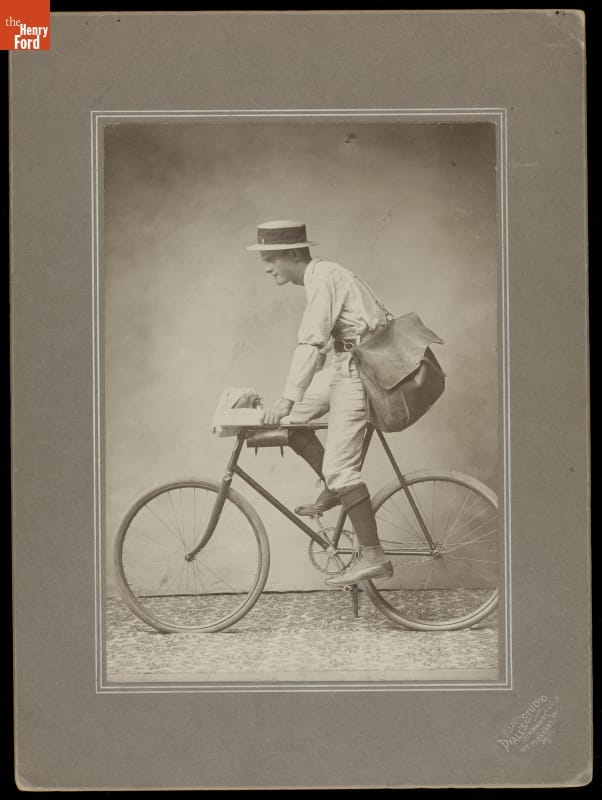
In 1902, the U. S. adopted Rural Free Delivery. Americans in the countryside would no longer need to go to town to get their mail -- the mail would be brought to them. Rural letter carrier, Orville J. Murphy, pictured here circa 1905, used a bike to deliver mail to outlying households around New London, Iowa. THF 201311
Since 1956, May has held the honor of being designated as National Bike Month. The holiday celebrates cyclists of all kinds across the United States and encourages everyone to get outside and hit the road on two wheels. Within the month of May one week is all about biking to work. This year National Bike to Work Week is May 16-20 and today, May 20, is Bike to Work Day.
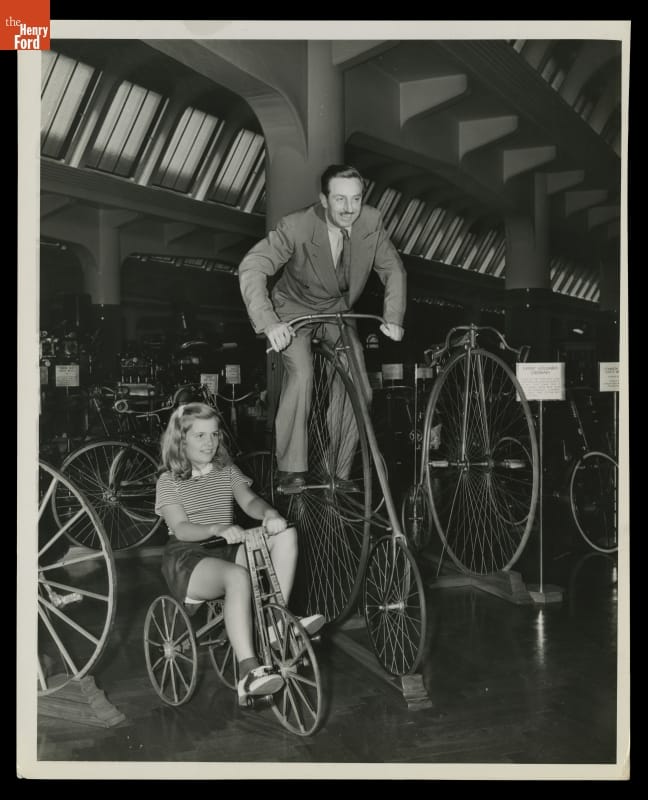
Here at The Henry Ford, bicycles are a big part of our staff members' work day, from our employees arriving by bike to our campus in the morning to using antique bikes to travel around Greenfield Village during the day as part of their daily routines. Online, our digital collections offer hundreds of artifacts all related to bicycles, from photos of bicycle races to a shot of Walt Disney trying out a high-wheel safety bicycle inside Henry Ford Museum in the 1940s, shown above, to this 1869 miniature bicycle used by Tom Thumb.
Continue Reading
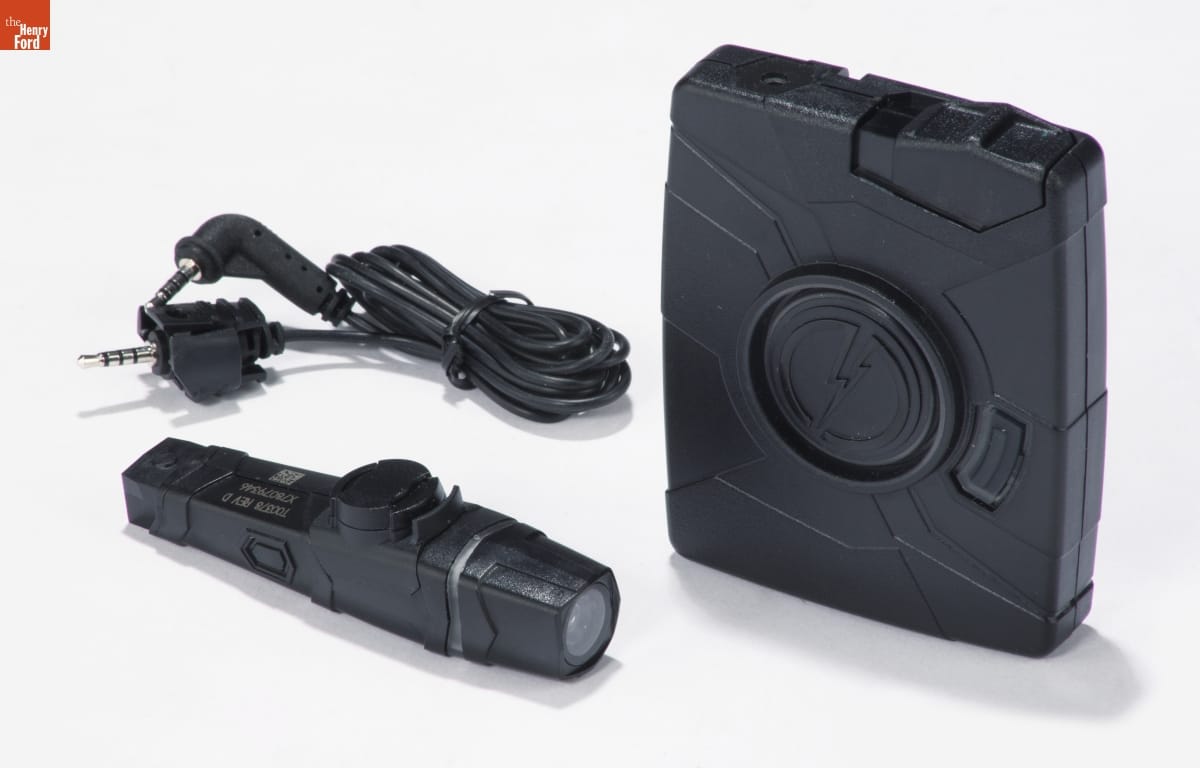
One of the many challenges curators face is collecting our contemporary history—they have to make difficult calls on what objects, clearly important today, will still have an important story to tell future generations. Last fall, Curator of Communication & Information Technology Kristen Gallerneaux accepted a donation of two body cameras designed to be worn by police officers. These cameras as artifacts represent increasing public calls in the 2010s for police transparency and accountability, encouraged in part by the Black Lives Matter movement. They also demonstrate the ways in which technology can be used by law enforcement to gather information. We’ve just digitized both of these Taser Axon cameras, including this 2013 model, making them available via our Digital Collections.
Ellice Engdahl is Digital Collections & Content Manager at The Henry Ford.
21st century, 2010s, technology, digital collections, by Ellice Engdahl

1949 Mercury Convertible, “kustomized” by George and Sam Barris.
Few names loom as large in the world of custom cars as that of George Barris. Mr. Barris, who passed away last November, will forever be associated with the many television and movie cars built by his Los Angeles shop – none more famous than the 1966 Batmobile, adapted from the 1955 Lincoln Futura concept car. But these high-profile cars were just one part of his work. Before Hollywood came knocking, George and his brother Sam had already built a reputation for their imaginative work with other cars, particularly the 1949-1951 Mercury models so loved by first-generation customizers. Indeed, just months before George Barris’s death, several Barris Mercurys were featured at the 2015 Pebble Beach Concours d’Elegance.
We are fortunate to have a Barris Mercury custom – or “kustom,” as Barris invariably spelled it – in the collections of The Henry Ford. Our 1949 Mercury features a chopped windshield; a padded, removable Carson top; frenched headlights and taillights; dechromed surfaces; and prominent “Barris” crests on the front fenders. For a Barris job of the 1950s, the modifications are mild, but sometimes less is more. The color is a deep metalflake purple, with lavender scallops. The scheme continues in the interior, upholstered in purple and white. In the “anything goes” spirit of the custom car hobby, there’s even a little Chevrolet in our Merc – the grille is out of a 1957 Corvette.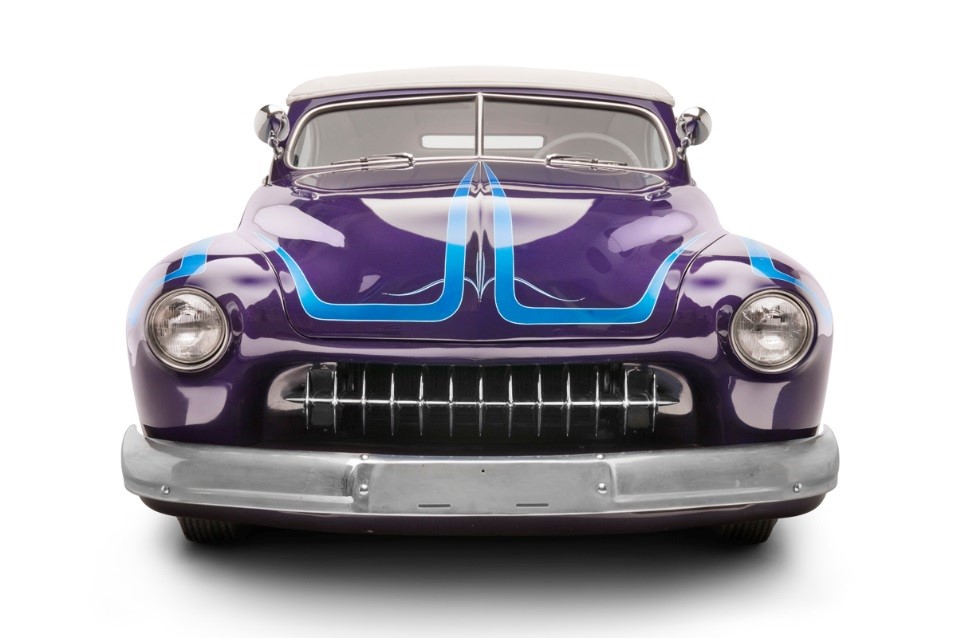
Our Barris ’49 Mercury isn’t all Blue Oval. There’s a bit of Bow Tie in that grille.
The 1949-1951 Mercurys, in stock form, were styled a bit behind the times. Their fenders and small windows looked dated next to other postwar cars – especially alongside their sister 1949 Fords. But those old lines appealed to southern California customizers. Lower the roof and suspension, and you turned a staid sedan into a head-turning – almost intimidating – street machine. Mercury customizers were also fond of removing chrome (famously excessive on production cars of that era), substituting parts from other cars, and applying deep, dark paints to the dramatic bodies. Radical or outlandish modifications hadn’t yet caught on in the field. Customizers essentially tweaked their cars to bring out a natural beauty that they already saw.
Our Mercury, then, is a classic example of these influential custom cars. It’s the perfect symbol for the customizer’s craft in Driving America, and a fitting tribute to one of the best-known “kustomizers” in the business.
Continue ReadingCalifornia, 1950s, 20th century, 1940s, making, convertibles, cars, by Matt Anderson
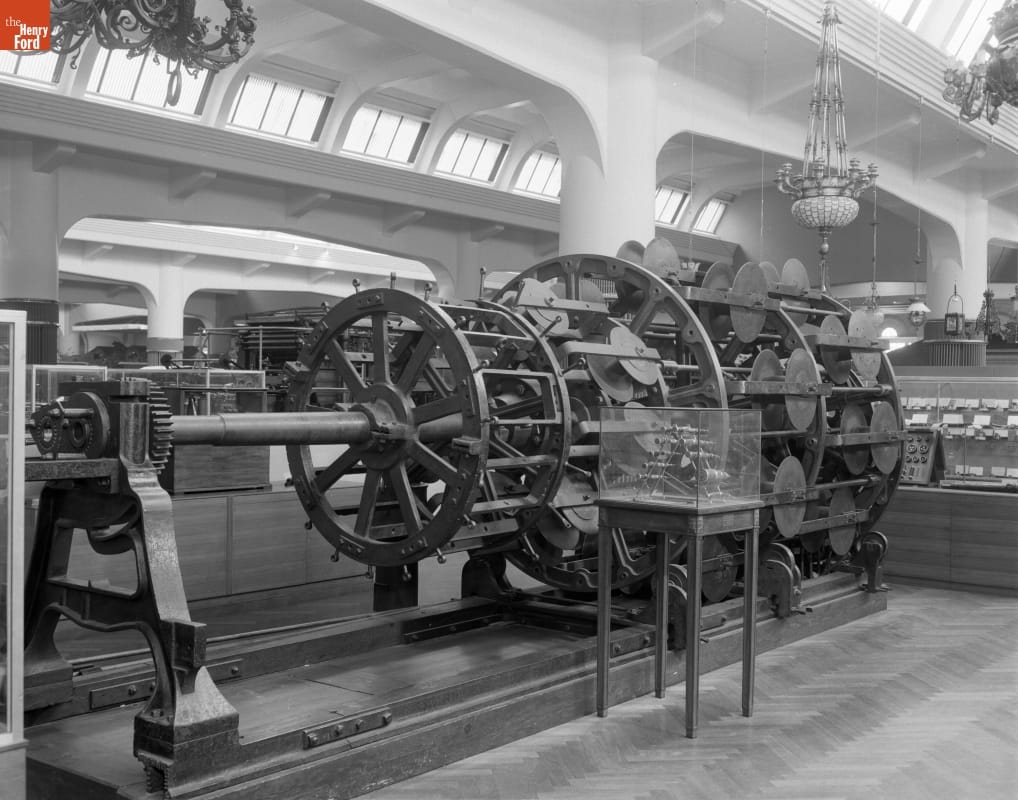
Cyrus Field wanted to wire the world. A successful paper merchant turned telecommunications pioneer, Field established the American Telegraphy Company in 1856 and set to work raising the funds and gathering the minds needed to bridge the oceanic divide between Europe and America.
In 1858, after several failed attempts, an underwater cable—capable of transmitting telegraph signals across the Atlantic Ocean—was laid from Valentia, Ireland, to Heart’s Content, Newfoundland. In August the first messages were sent, including an exchange between Queen Victoria and President Buchanan. It took 17 hours to transmit Queen Victoria’s 98 words. The triumph of the 1858 cable was short-lived; a month later, it failed, a victim of excess voltage in an attempt to increase the speed of messages.
This cable machine, built by Glass, Eliot & Co., was used to prepare telecommunications cable at Enderby’s Wharf in Greenwich, England, for the second transatlantic cable. Machines like these were used to create the core of submarine cable from iron and conductive copper—and then moved aboard a ship, where they applied a protective sheath made of galvanized steel, an insulating layer of gutta-percha and a final layer of jute to protect against abrasion. One mile of finished cable weighed almost a ton, but it was as flexible as a rope, built to withstand the pull of the ship laying it and hazards on the ocean floor.
In 1865, 2,300 nautical miles of cable were carried aboard the leviathan iron steamship, the SS Great Eastern. The ship left in July but was forced to return to port when the cable snapped and the end was lost at sea. A second cable excursion began a year later and was successful. This was the first truly sustainable and durable telegraph cable, continuing to carry the Morse code “text messages” of telegraph operators across continents—at a rate 80 times faster than the first cable. It remained in operation until the mid-1870s, by which time four additional cables had been laid.
This machine was essential to the “wiring of the world,” reorganizing basic materials into the spine of the first permanent transcontinental telecommunications network. These submarine cables—like the modern-day fiber-optic cables that carry the signals of Internet traffic—connected cultures and communities. Continue Reading
1860s, 1850s, 19th century, telegraphy, technology, communication
Archaeology's Underground
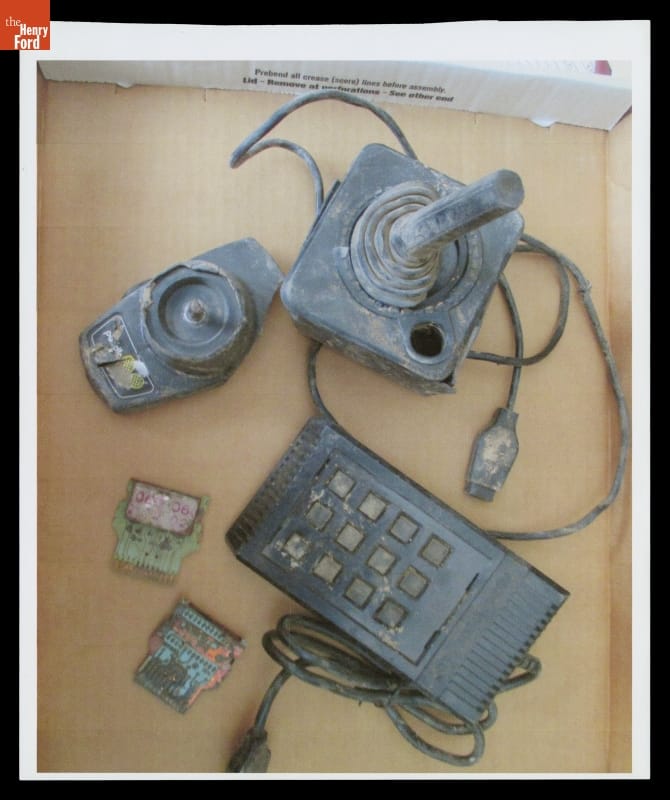
Artifacts Recovered from an Alamogordo, New Mexico Landfill, April 2014, Site of the 1983 Atari Video Game Burial - THF122265
The Strongest Sandstorm of the Year
A 30-foot-deep pit in constant danger of collapsing in on itself. Mercury-laced pig remains. Unexploded World War II ordnance. Poisonous gas. Two years ago, the threats were real in the desert landscape of Alamogordo, New Mexico, as archaeologists prepared to commence an important historical dig.
For video games. In a landfill.
In April 2014, the Atari burial ground of urban legend was excavated and artifacts exhumed to worldwide media acclaim. More important, a global conversation about what archaeology is or should be began. And a new strand of the scientific study of human history, culture and its preservation that had been somewhat underground was given newfound legitimacy. 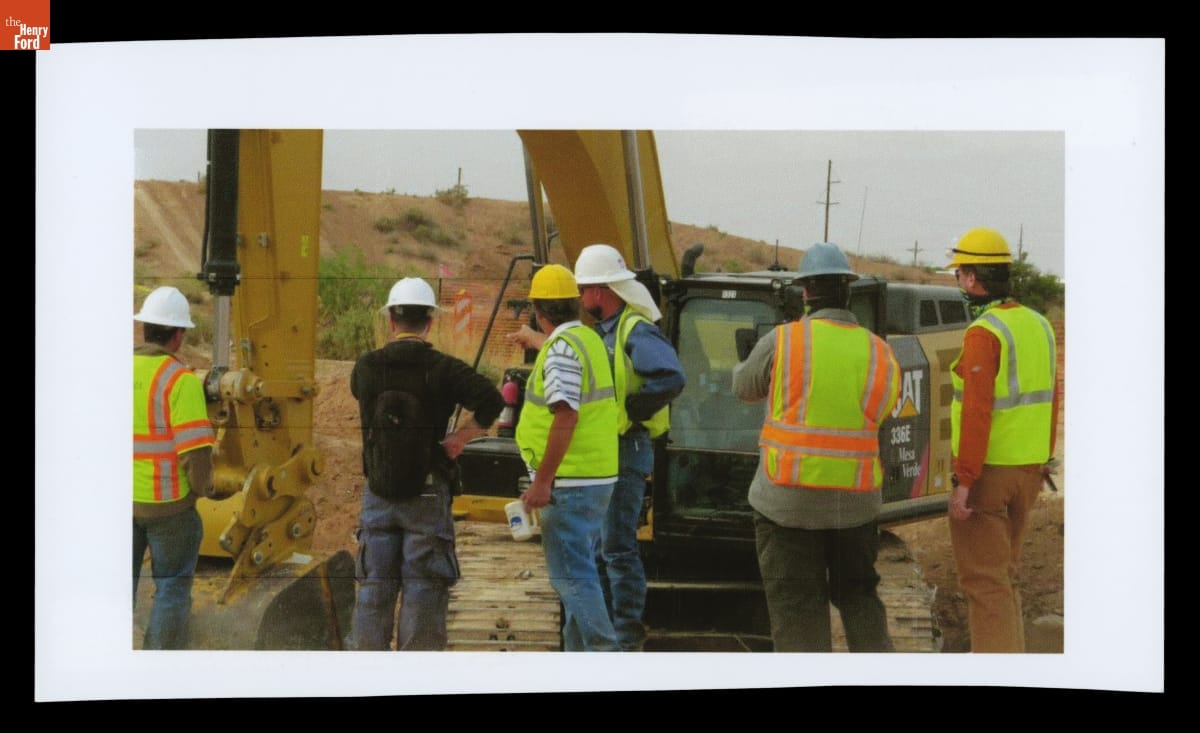
Excavation Crew in April 2014 at the Alamogordo, New Mexico Landfill, Site of the 1983 Atari Video Game Burial - THF122241
Punk Archaeology
Known as “archaeology of the recent past,” punk archaeology is archaeology at the margins, focusing on documenting and preserving histories and cultures thought of by others as either too strange or obscure for serious study. Thriving on a DIY work ethic, volunteerism and community outreach, it bridges the gap between science and instant communication with a curious public.
This movement began in 2008 when two professors of archaeology, Bill Caraher and Kostis Kourelis, started casual conversations about how quite a few Mediterranean archaeologists they knew of also had punk rock associations or predilections. Those chats jump-started a blog, where the two started bantering online about themes shared between punk rock and their own archaeological methods. How punk rock and archaeology share an irreverence of tradition, an interest in abandoned spaces and see value in objects discarded. How they both embrace destruction as part of the creative process. How punk music has archaeological underpinnings in its songs — not in their reproduction of the past necessarily, but in their preservation of the past through brazen critique.
The blog ultimately led to the publication of the book Punk Archaeology, a manifesto of sorts about how we can use punk music as a tool to think about archaeology in different, more playful ways. But like punk, the play is serious and has, at its core, a social conscience.
As a collective study, punk archaeology realizes that as the speed of consumerism and technology continue to increase at such a rapid rate, it threatens to leave no real archaeological record. That by recording the recent past and the artifacts left behind almost as it happens, punk archaeologists can retain information for future use by scholars of culture, technology and even trash. Punk archaeology strives to give a voice to history that can be too easily ignored or forgotten by the mainstream.
The now-infamous Atari excavation marked the first official punk archaeology gig using real archaeological methods for digging, documenting and preserving artifacts less than 50 years old. I was lucky enough to lead the team on the dig, which included Caraher, Richard Rothaus (fearless field director), Raiford Guins (video game historian) and Bret Weber (sociologist).
All of us have one foot in punk history and the other foot in either classical antiquity or the American West. We were willing volunteers, happy to participate in a project that would be a first-of-its-kind technology excavation. All captivated by the weirdness surrounding the story behind it and mindful of how punk embraces the weird and does so on a shoestring.
A Tale of Trash
Urban legend had it that in 1983 video game giant Atari buried millions of copies of its notorious flop, E.T. — The Extra-Terrestrial, in a landfill in the New Mexico desert. Trucked over from Atari’s warehouse in El Paso, Texas, and dumped, the games sat among heaps of trash, subject to nightly thefts by adventurous kids who would sneak in and grab from the pile, until everything was finally driven over with heavy machinery and covered with a slurry of concrete and alternating layers of sand and garbage.
The facts and fiction of the tale had long been debated in certain circles. Some rumors claimed that Atari buried the goods to rid itself of the game thought to have singlehandedly caused the video game crash of the mid-1980s. Others said that the dump never happened. No way could a company as huge as Atari do such a thing.
Years later, online chat rooms still continued to buzz, speculating about the truth of the legendary disposal and cover-up, with some Internet conspiracy theorists claiming that perhaps as many as 5 million games had been buried, still entombed beneath a solid concrete slab.
Finally, 30 years after the supposed event, a film production company secured the rights from the city of Alamogordo to excavate the old landfill as part of the documentary Atari: Game Over on the video game crash. When I learned of this agreement, I wrote to Fuel Entertainment to see how they planned to manage the “archaeology” of the excavation. A few months later, our team was invited to participate.
We reached the Atari level 30 feet underground on April 26, 2014, to the cheers of hundreds of Alamogordo residents, gamers, pop-culture mavens, news media and even the creator of the E.T. video game, Howard Scott Warshaw. Copies of more than 40 Atari games, plus Atari 2600 consoles and controllers, were excavated, some still boxed, in shrink wrap or with price tags from Target and Wal-Mart on them.
So a legend was proven true. But what about the archaeology? And what should be done with the artifacts recovered and the stories they held?
As we examined the recovered games, we spoke to the crowd and to the media. Traditional archaeological digs and excavations rarely have public onlookers, but we welcomed the audience, sharing what we found. Punk archaeology is public archaeology. And while the Internet usually takes a passing interest in archaeological projects, typically leaving any news of discoveries to professional journals and books, this was different. The excavation of the Atari burial ground trended globally on Twitter and Facebook, prompting a public debate as to what archaeology is.
For all of us on-site in New Mexico, the excavation yielded artifacts from our recent past that had been discarded as trash — considered artifacts now because they represent a culture, a heritage for people of a certain age. They are a statement to the corporate culture and mindset of a time. 
E.T. the Extra-Terrestrial," Recovered from Landfill, Alamogordo, New Mexico, April 26, 2014, Site of the Atari Video Game Burial of 1983- THF159970
And now, they are recognized for their significance by the likes of institutions such as The Henry Ford, the Smithsonian Institution, the Strong Museum of Play and the Vigamus video game museum, all of which accepted items recovered from the Atari burial ground as part of their collections — once again giving further legitimacy to the legend, the dig and the recovered items as important artifacts in the study of 1980s pop culture and human history.
Continue Reading
technology, toys and games, video games, The Henry Ford Magazine, by Andrew Reinhard
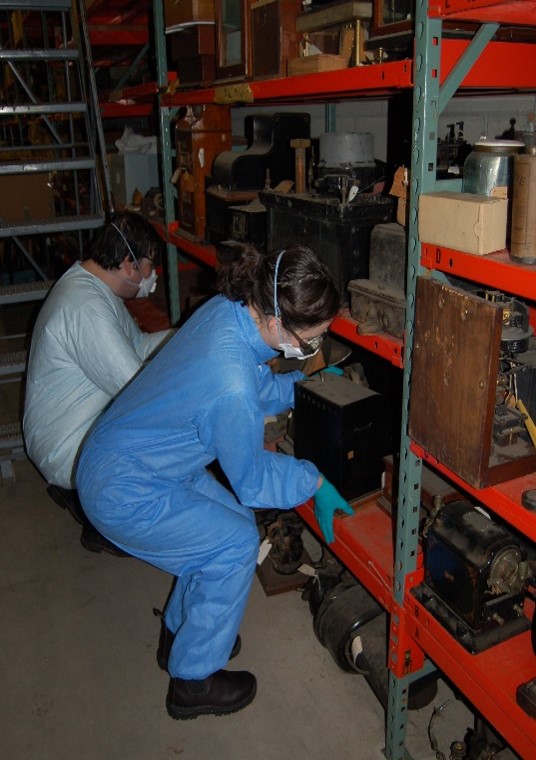
Conservation specialist Mallory Bower and collections specialist Jake Hildebrandt removing objects from shelving in the Collections Storage Building. The Henry Ford has recently embarked on a new adventure, thanks to a grant from the Institute of Museum and Library Services (IMLS) which allows us to spend time working on the electrical collections currently housed in the Collections Storage Building. This is The Henry Ford’s second IMLS grant dedicated to improving the storage of and access to collections. The first grant focused on communications technology, and was completed over two years, ending in October 2015. At the end of that grant, more than 1000 communications-related objects were conserved, catalogued, digitized, and stored, marking a huge improvement in the state of the collections and their accessibility. We have similar goals for this grant, as we aim to complete 900+ objects by October 2017.
The Henry Ford has recently embarked on a new adventure, thanks to a grant from the Institute of Museum and Library Services (IMLS) which allows us to spend time working on the electrical collections currently housed in the Collections Storage Building. This is The Henry Ford’s second IMLS grant dedicated to improving the storage of and access to collections. The first grant focused on communications technology, and was completed over two years, ending in October 2015. At the end of that grant, more than 1000 communications-related objects were conserved, catalogued, digitized, and stored, marking a huge improvement in the state of the collections and their accessibility. We have similar goals for this grant, as we aim to complete 900+ objects by October 2017.
digitization, electricity, power, by Louise Stewart Beck, conservation, collections care, IMLS grant, #Behind The Scenes @ The Henry Ford
Ford Motor Company’s First Home

The first Ford Motor Company vehicle ever produced was made at the company’s first factory, located on Mack Avenue in Detroit. The Mack Avenue Plant is so significant to Ford history that it was reproduced, at a smaller scale, in Greenfield Village in 1945. We’ve just digitized a few images related to the original Mack Avenue Plant, including this 1903 photograph of plant employees. Visit our Digital Collections to see more artifacts related to Mack Avenue.
Ellice Engdahl is Digital Collections & Content Manager at The Henry Ford.
Greenfield Village buildings, Greenfield Village, Ford Motor Company, digital collections, by Ellice Engdahl
Practicality Enshrined: The L. Miller and Son Hardware and Tool Display
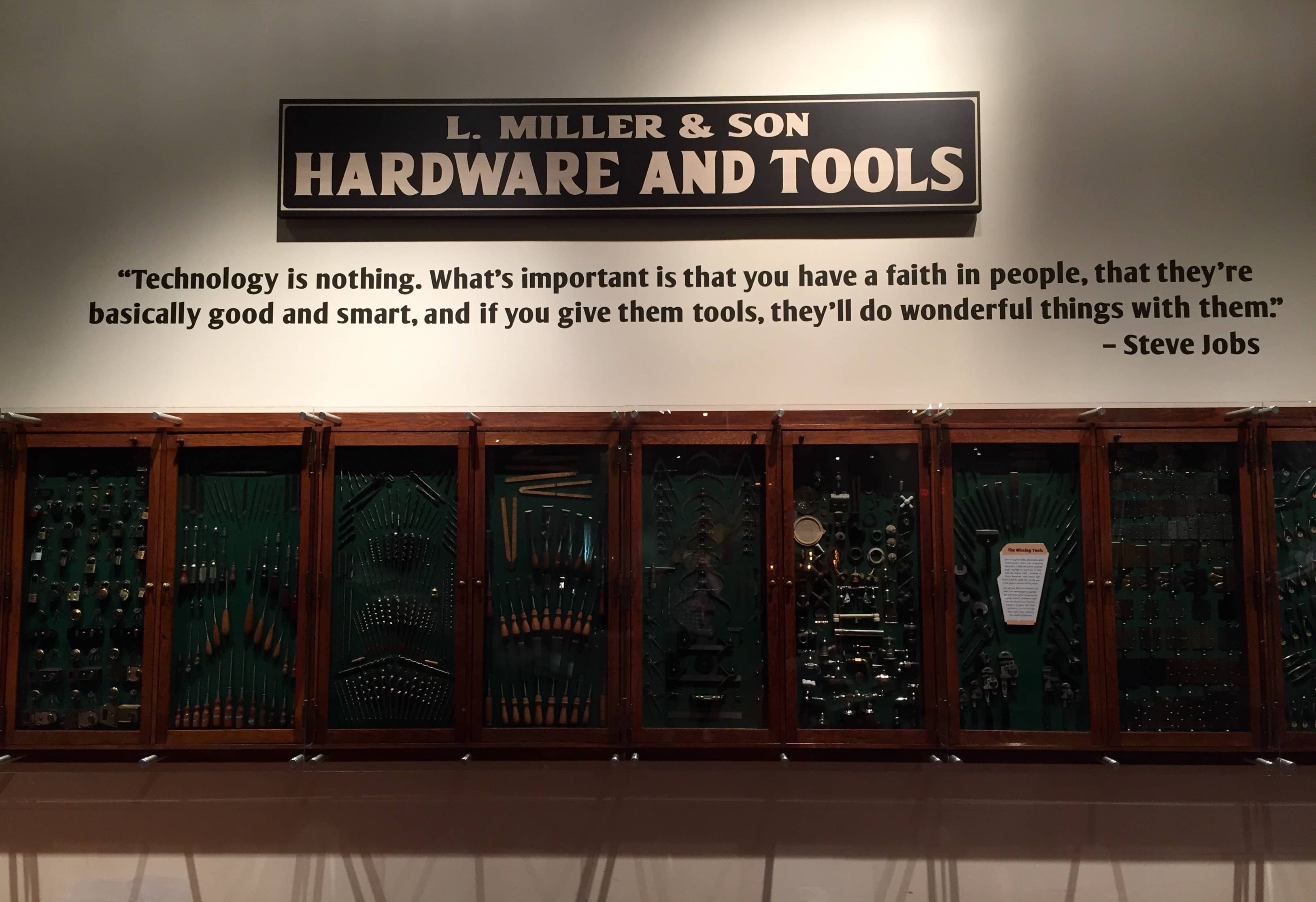
Go to the back of the museum, over in the area filled with hulking power-generating machinery, next to the grey mass of the Spokane water turbine, and you’ll find something new. Or rather something almost a century old that’s new to the area. Actually, you’ll find twelve things. Or rather 795. Okay, let me explain…
What you’ll find is a group of 12 display panels created in the mid-1920s for the L. Miller and Son lumber and hardware store of 1815 W. Division Street, Chicago, Illinois. The installation consists of six panels of hand tools and six of hardware, all logically, carefully, and gracefully arrayed on green felt backing, mounted in glass-fronted doors. Now they are arranged gallery-like on the wall, but originally they hinged out of a floor-to-ceiling cabinet system of shelves, bins, and drawers custom-fitted into the store’s long narrow retail space.
The original business was founded by Louis Miller, a Russian immigrant who had arrived in the United States in 1894. Miller and his family served a neighborhood made up of immigrants from Poland, Germany, Russia, and Ukraine (the second and third floors of part of the store property housed Russian and Polish social clubs). The clear visibility of the store’s stock of tools and hardware made it easier for customers with a language barrier to find what they needed. The display’s elegant arrangement was great salesmanship but could also serve a problem solving function: viewing tools and components is rather like scanning a menu of possible solutions.
The neighborhood underwent several transformations over the years. The final wave of European immigrants, primarily from Poland, arrived in the 1940s and 50s as refugees; Kennedy Expressway construction cut a wide swath through the area, and once completed in 1960 served to cut it off from neighborhoods to the east; by the 1970s many residents were fleeing to the suburbs and the area was becoming rife with gang activity. The store, in its original location on Division (the “Polish Broadway” that served as the dividing line between the Wicker Park and East Village neighborhoods), endured through all these changes except for the most recent: gentrification. The subsequent rise in property taxes finally prompted the need for the company to move to a new location.
How Did the Exhibit Make Its Way to The Henry Ford?
During the 1950s the owners had already phased out the hardware side of the business in order to concentrate on lumber and construction materials. The display remained in place, fondly remembered—and occasionally visited—by a dwindling number of locals. In early 2011, with the business’s move looming, owner Bob Margolin (grandson of the founder) and I began to discuss The Henry Ford’s potential interest in acquiring the display. In April Bob indicated that he would be travelling to Michigan on business and we agreed that bringing a sampling of the display—a panel or two to look at more closely—would be a good idea. On the sunny afternoon of Friday April 29 I went out to meet him in our employee parking lot adjacent to Lovett Hall: he hadn’t brought a sampling, he’d brought the entire display, and had already started carefully propping the panels adjacent to one another against the side of his van—much to the fascination and enthrallment of numerous staff leaving for the day. An amazing sight, it was as if the display had lurched out of the shadows to literally claim a day in the sun—and offer a kind of final proof of its sales power, even though there was no longer any stock of tools for it to sell.
The acquisition went ahead. Now, precisely five years later, the display is on exhibit. It is a museum of tools within a larger museum. It is an artifact in its own right but it is made up of artifacts. It is made up of stunningly ordinary stuff—the workaday items ordinarily built into homes or hidden in toolboxes—but it celebrates everyday practicality and resourcefulness. Like a great many museum artifacts it is a paradox: in a state of rest, set sparkling in Made in America—but also active, continuing to work its magic, prompting an urge to build, fix, construct—making you want to somehow do something…
Marc Greuther is Chief Curator and Senior Director, Historical Resources at The Henry Ford.
Learn more about the L. Miller and Son Hardware and Tool Display in this collection of artifact cards.
Illinois, 1920s, 21st century, 20th century, shopping, making, Made in America, immigrants, Henry Ford Museum, communication, by Marc Greuther
Innovation Steeped in Learning
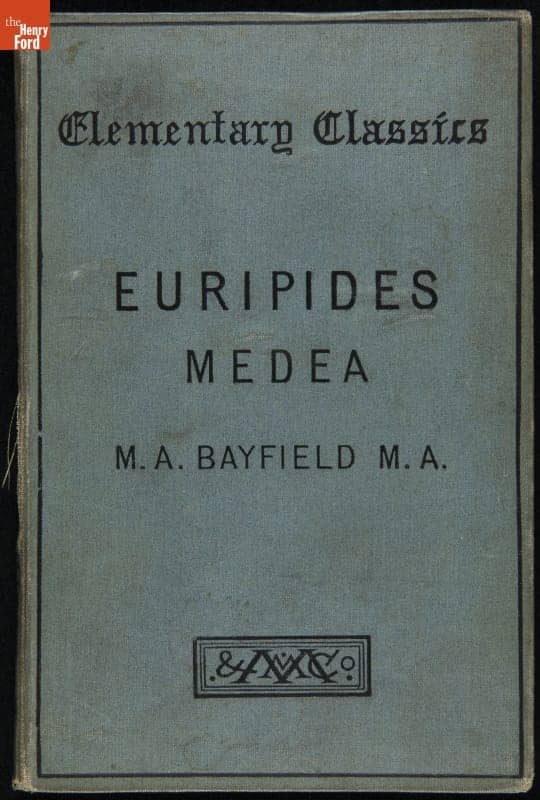
If you visit the Wright Home in Greenfield Village, the presenter in the house will probably draw your attention to the bookcase in the living room. Many of these books, along with more housed in the Benson Ford Research Center, did indeed belong to the Wrights, and were used by Orville and Wilbur Wright, their sister Katharine, or their father Milton. We’ve just digitized over 50 Wright family books, including this 1892 copy of Medea used by Katharine Wright. Other examples include The Principal Works of Charles Darwin, Grimm’s Fairy Tales, and A Manual of Instruction in Latin. Browse the list of titles to see what other bookish ideas may have influenced the young Wright Brothers by visiting our Digital Collections.
Ellice Engdahl is Digital Collections & Content Manager at The Henry Ford.
Ohio, home life, Wright Brothers, Greenfield Village buildings, Greenfield Village, digital collections, childhood, by Ellice Engdahl, books, 19th century
Yellowstone, America’s First National Park
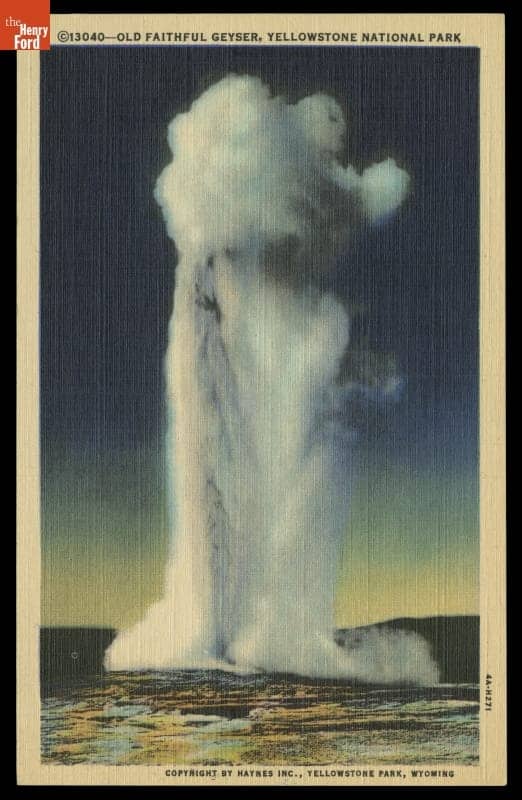
Postcard, Old Faithful Geyser, 1934
Yellowstone National Park, the first national park established in 1872, was a uniquely American innovation. Like the Declaration of Independence, it embodied America’s democratic ideals—in this case, the groundbreaking idea that our magnificent natural wonders should be enjoyed not by a privileged few but by everyone. The inscription over Roosevelt Arch at the north entrance to the park, "For the Benefit and Enjoyment of the People," symbolizes the ideals that established Yellowstone and defined the vision for all national parks to come.
Come now on a virtual tour through The Henry Ford’s collection to view the wonders of Yellowstone National Park.
Postcard, Entrance Gateway, 1903-4
Imagine it is the early 1900s, and you’ve chosen to take the four-day guided tour through the park by horse-drawn carriage. From the north entrance, you travel through towering canyons to your first stop, Mammoth Hot Springs. 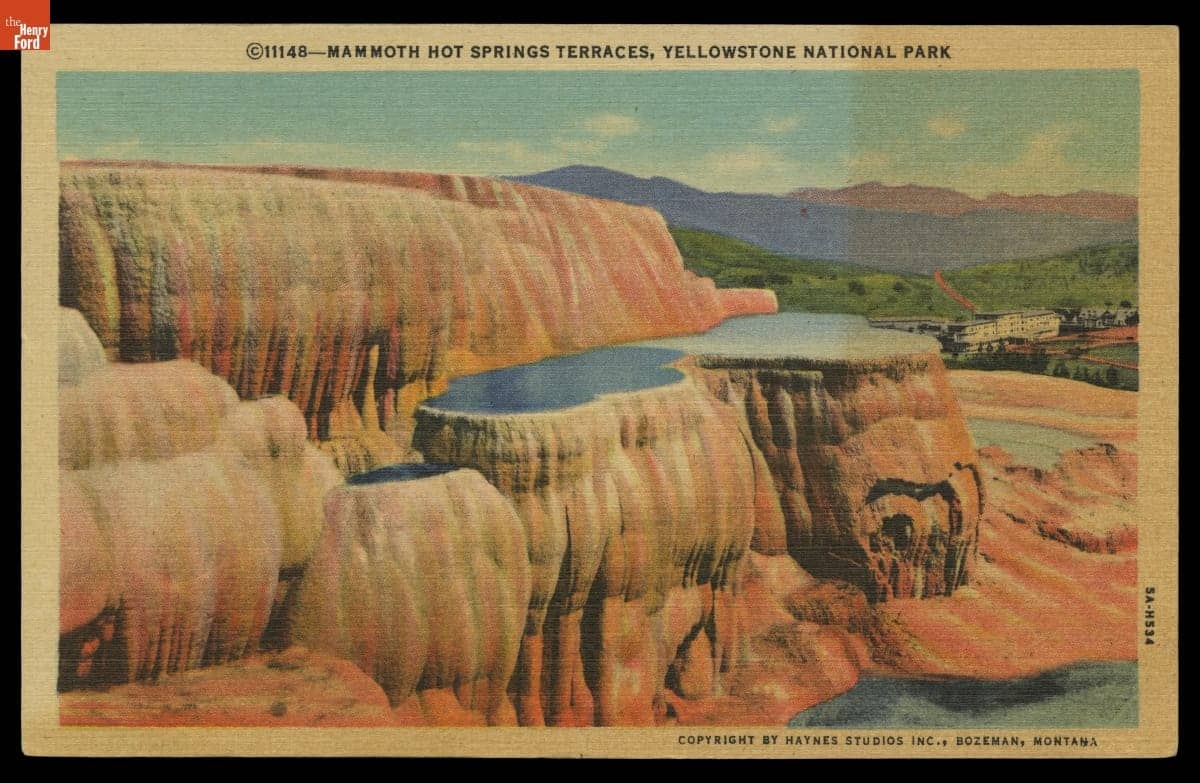
Postcard, Mammoth Hot Springs Terraces, 1935
The hot springs there, heavily charged with lime, have built up tier upon tier of remarkable terraces. The springs are constantly changing, presenting what one guidebook calls “an astonishing spectacle of indescribable beauty.” After viewing the hot springs and walking among its many terraces, you spend your first night at the humble but serviceable Mammoth Hot Springs Hotel.
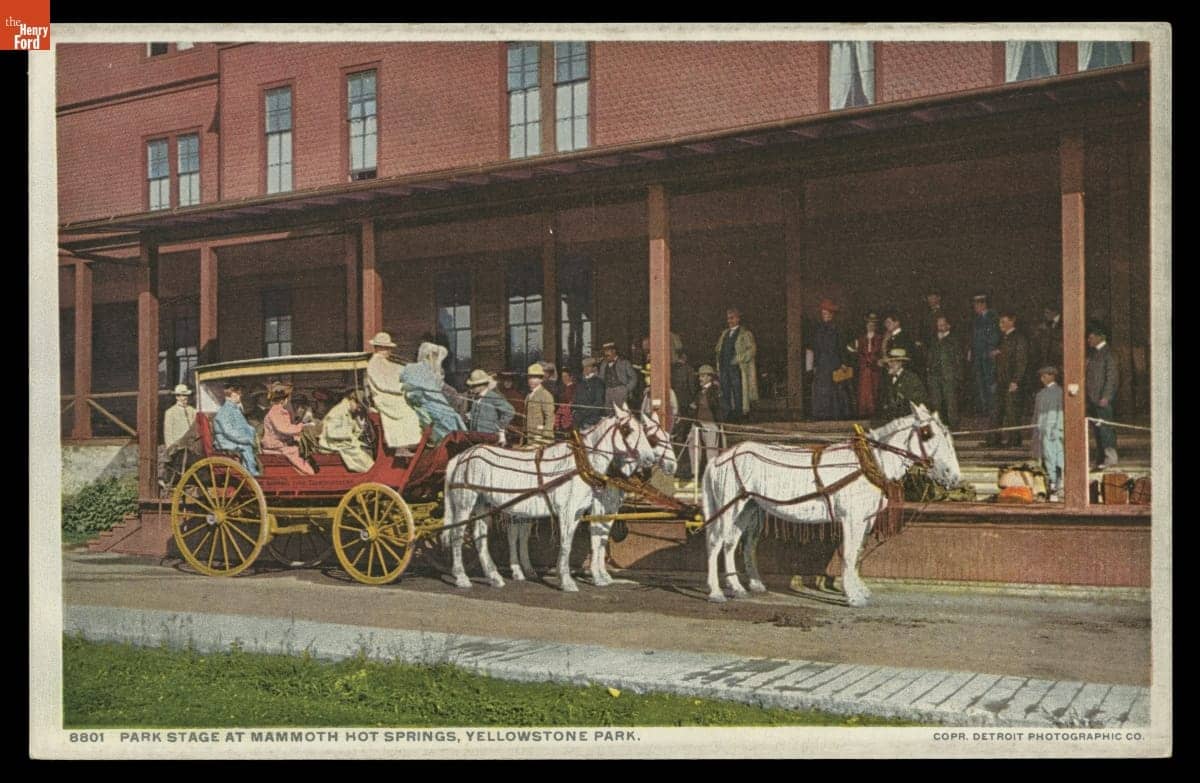
Postcard, Park Stage at Mammoth Hot Springs, 1904-5
The next day, anticipation builds as you head south into the area with all the geyser activity. You pass Roaring Mountain, so named for the sound of steam fumaroles that became very active and noisy there in 1902.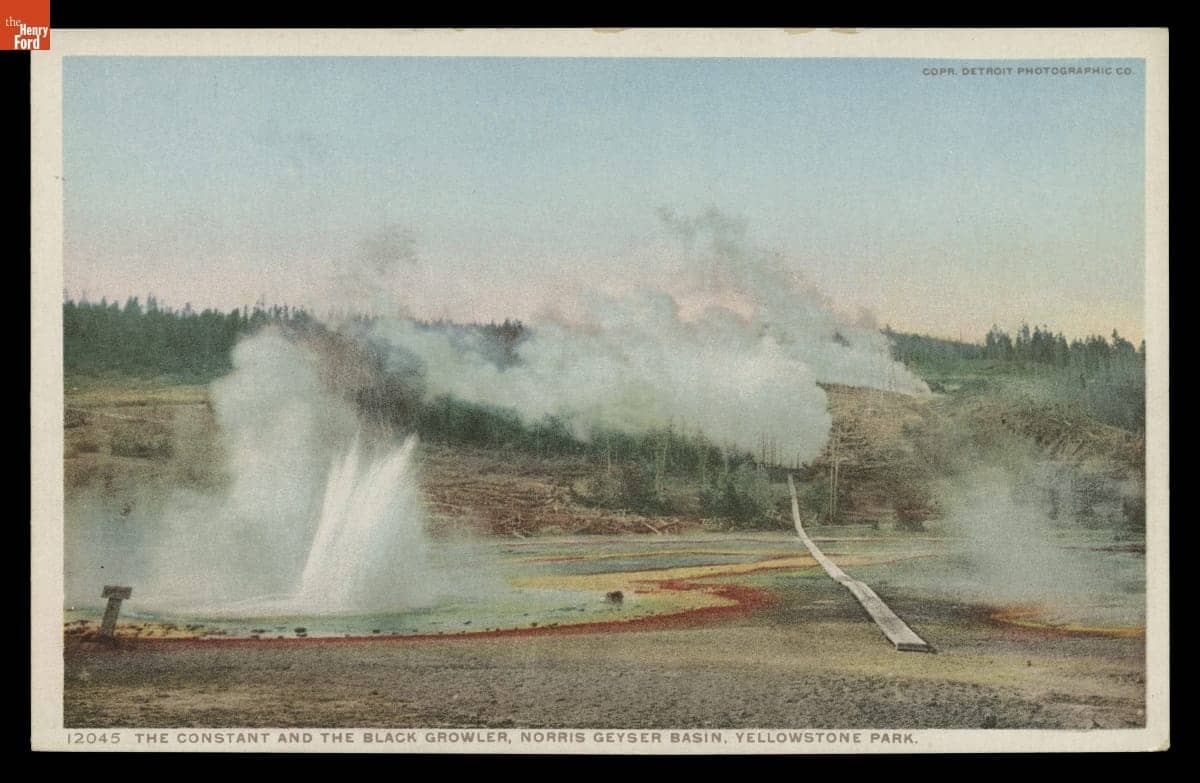
Postcard, The Constant and the Black Growler, Norris Geyser Basin, 1908-9
Before long, you reach the first great geyser basin: Norris Geyser Basin. At the intersection of three major earthquake fault zones, Norris is the hottest, most active geyser basin in the park. Underground water temperatures of 706 degrees Fahrenheit have been measured. Norris has it all: hot springs, geysers, fumaroles, and bubbling mud pots. 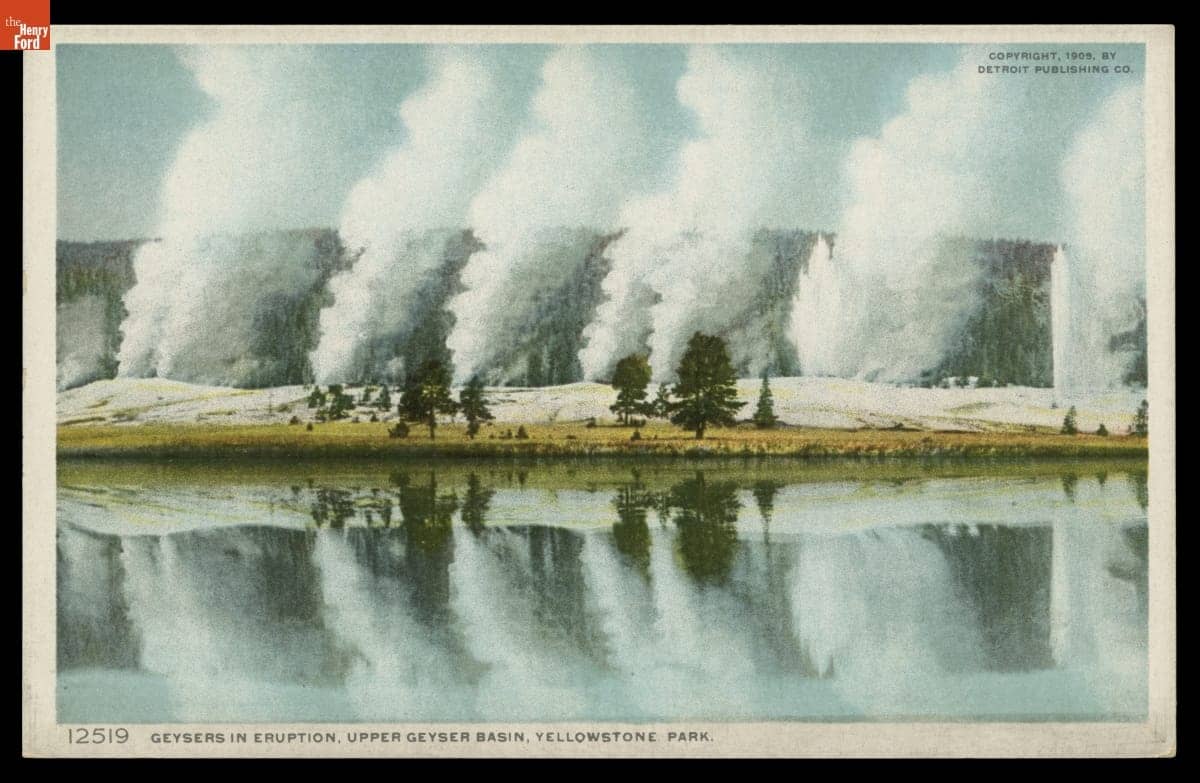
Postcard, Geysers in Eruption, Upper Geyser Basin, 1908-9
From Norris, you proceed to Lower and Middle Geyser Basins until you finally reach Upper Geyser Basin—the place you’ve heard so much about. Approximately two square miles in area, Upper Geyser Basin contains the largest concentration of geysers in the park—in fact, nearly one-quarter of all of the geysers in the world! A variety of other thermal features also exist here, including colorful hot springs and steaming fumaroles.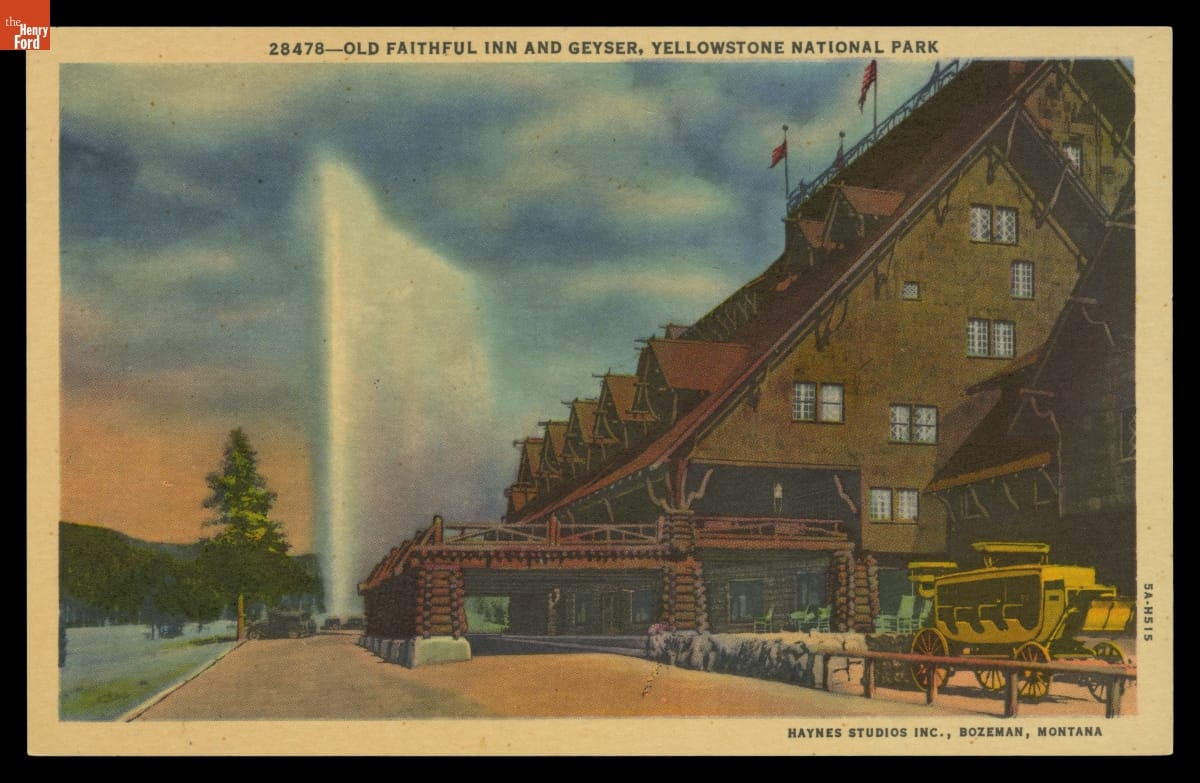
Postcard, Old Faithful Inn and Geyser, 1935
Upper Geyser Basin is home to Old Faithful, the most famous and celebrated geyser in the world. The 1870 Washburn Expedition camped near this geyser. They were the ones who named it Old Faithful, because they discovered it had frequent and regular eruptions. It can last from 2-5 minutes, reach a height of 90 to 184 feet, and emit 10,000 to 12,000 gallons of water at a time.

The Lobby, Old Faithful Inn, 1904-5
You stop for the night here at Old Faithful Inn, a grand hotel built in 1903. Most resort hotels at the time were intended to serve as civilized oases from the wilderness. However, Old Faithful Inn, the first true rustic-style resort, was designed by young, self-taught architect Robert Reamer to fit in with nature rather than to escape from it. The inside of the hotel continues the rustic look, with a spectacular seven-story log-framed lobby containing a massive stone fireplace. 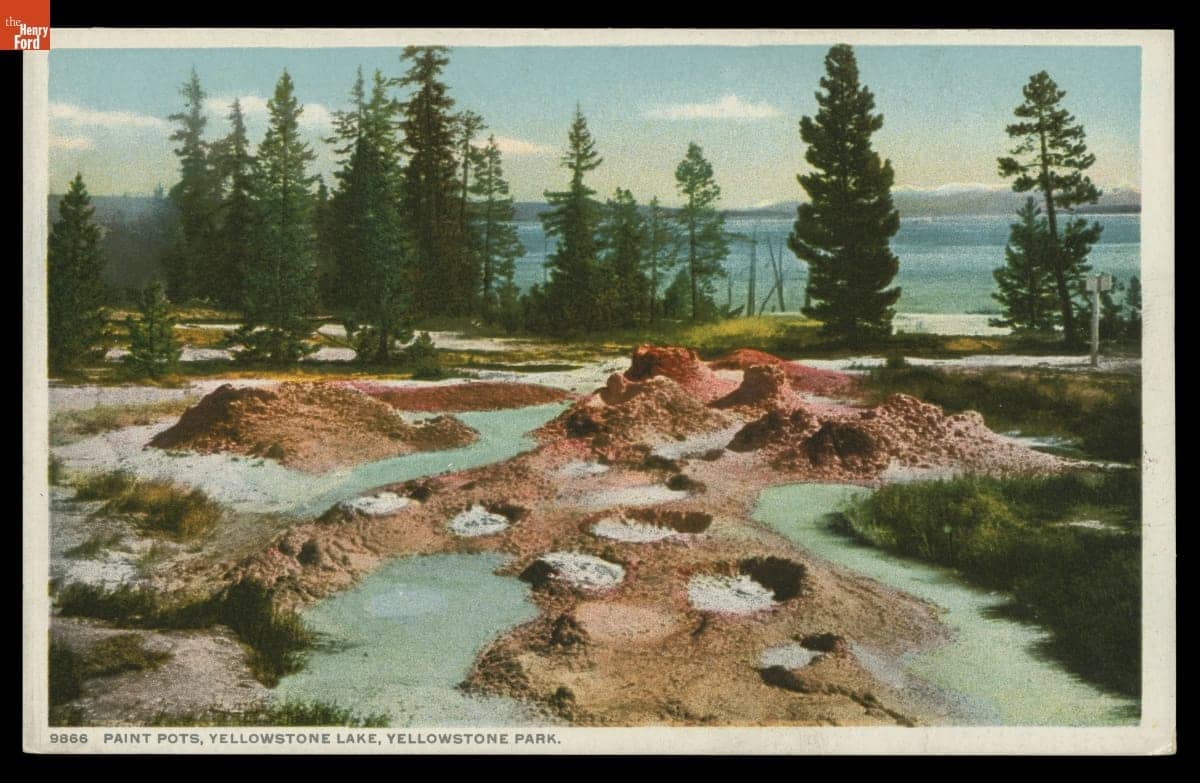
Postcard, Paint Pots, Yellowstone Lake, 1905-6
Heading down the road, West Thumb Geyser Basin is one of the smaller geyser basins in Yellowstone. Located along the edge of Yellowstone Lake, it consists of a stone mantle riddled with hot springs. These resemble vast boiling pots of paint with a continuous bubbling-up of mud.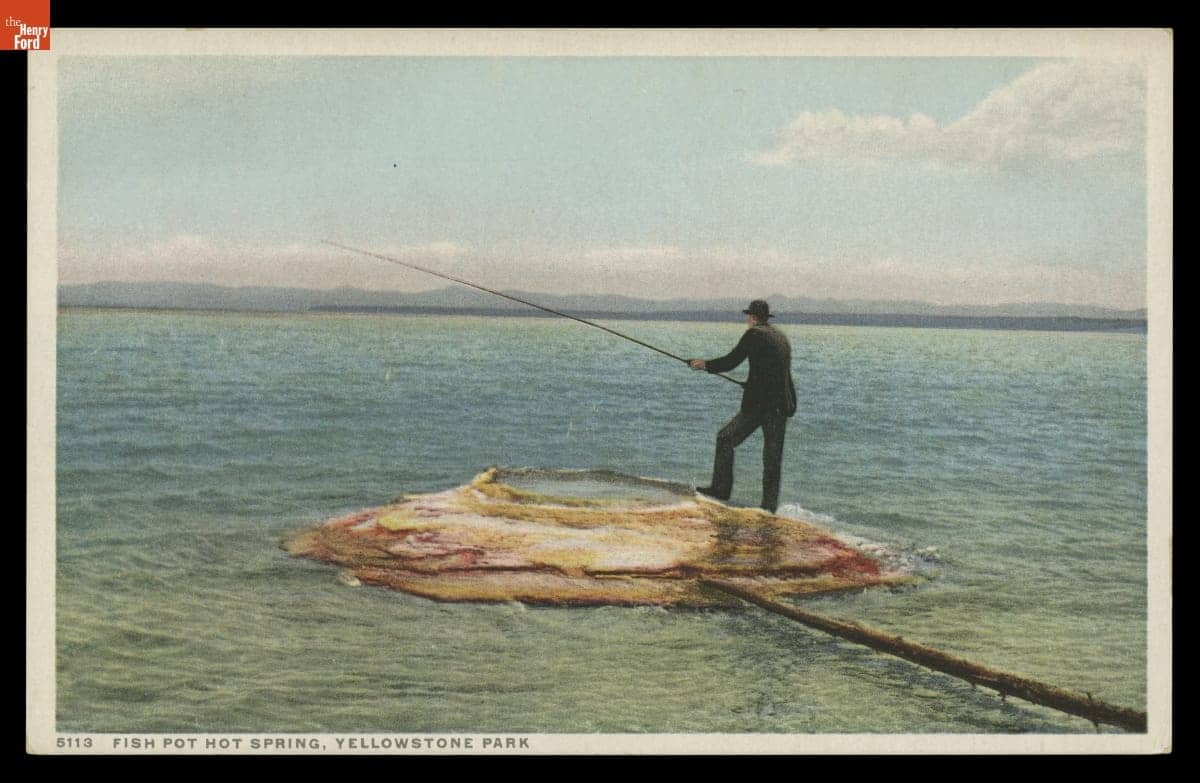
Postcard, Fish Pot Hot Spring, 1901
About 30 miles from Upper Geyser Basin is Yellowstone Lake—one of the coldest, largest, and highest lakes in North America. The lake includes 110 miles of shoreline and reaches depths of up to 390 feet. The bottom of the lake remains a constant 42 degrees Fahrenheit year-round. 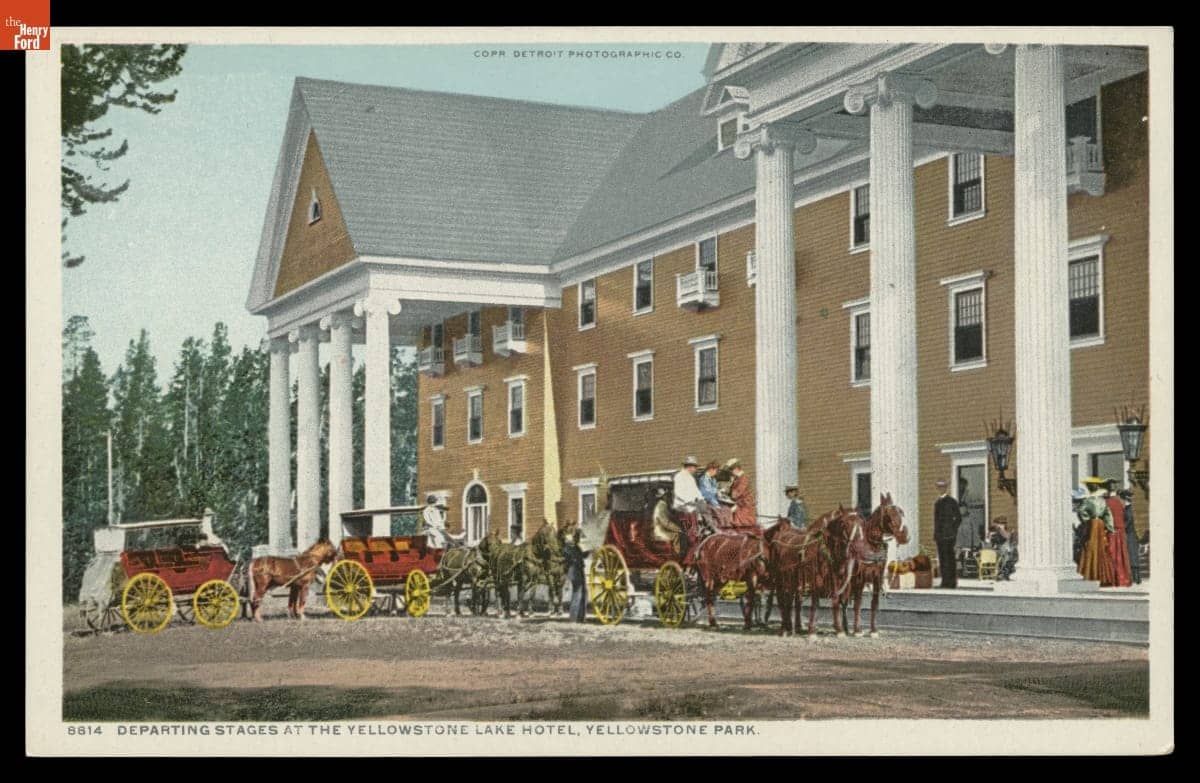
Postcard, Lake Hotel, 1904-5
Here you rest for the night at the charming Yellowstone Lake Hotel, the oldest surviving hotel in the park, built in 1891. Robert Reamer added the colonial-style columns to this quintessential Eastern-styled hotel in 1903.
Heading back north along the park’s Grand Loop Road, Hayden Valley is filled with large, open meadows on either side of the Yellowstone River—the remains of an ancient lakebed. The valley is the year-round home to bison, elk, and grizzly bear.
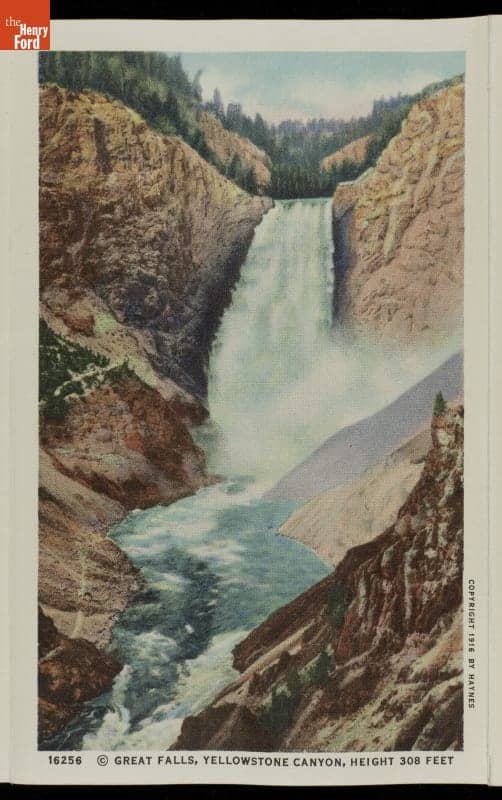
Postcard in souvenir viewbook, Great Falls, 1934
As the Yellowstone River flows north from Yellowstone Lake, it leaves the Hayden Valley and takes two great plunges: first over the Upper Falls and then, a quarter mile downstream, over the Lower Falls—at which point it enters the Grand Canyon of the Yellowstone. In places, the canyon walls drop some 1,000 feet to the river below. You spend the night at the last of the four great Yellowstone resorts, Grand Canyon Hotel, before returning to Mammoth Hot Springs and the end of your tour.
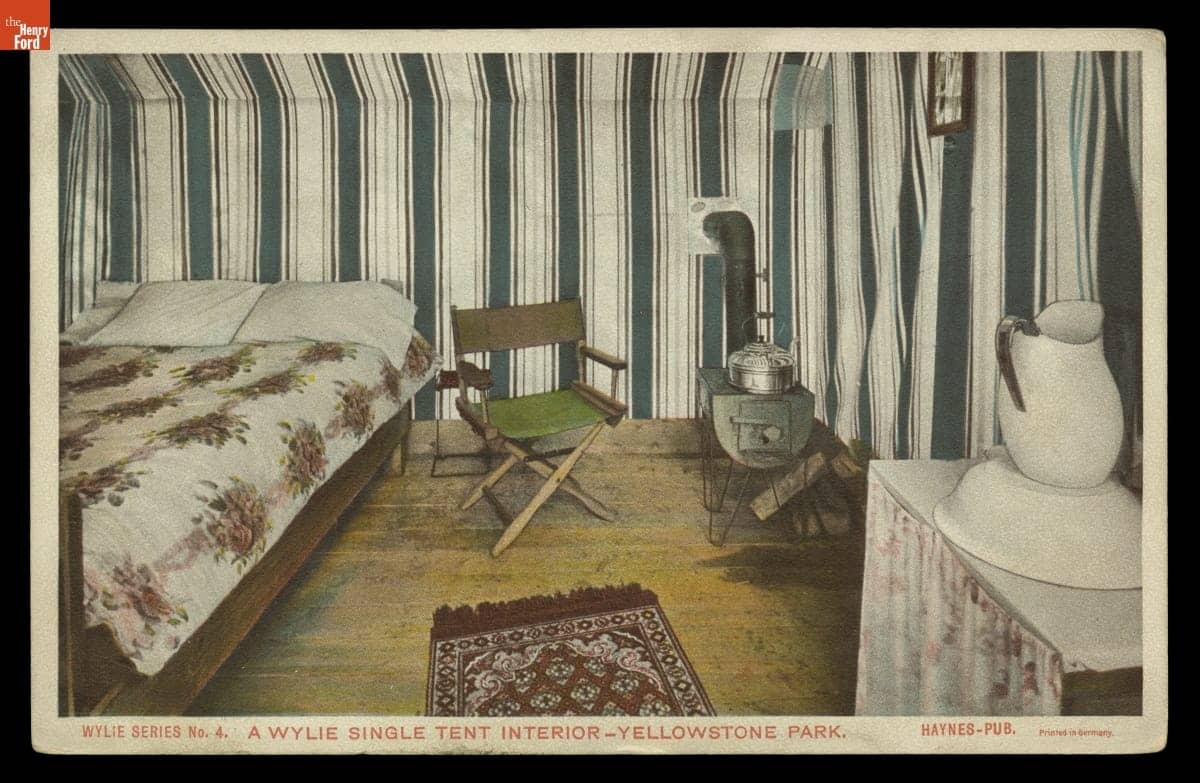
Postcard, A Wylie Single Tent Interior, about 1910
Those who can’t afford the type of tour you’ve just taken can choose the less expensive “Wylie Way,” which involves seeing the sites from a Wylie stagecoach and lodging in a canvas tent overnight. 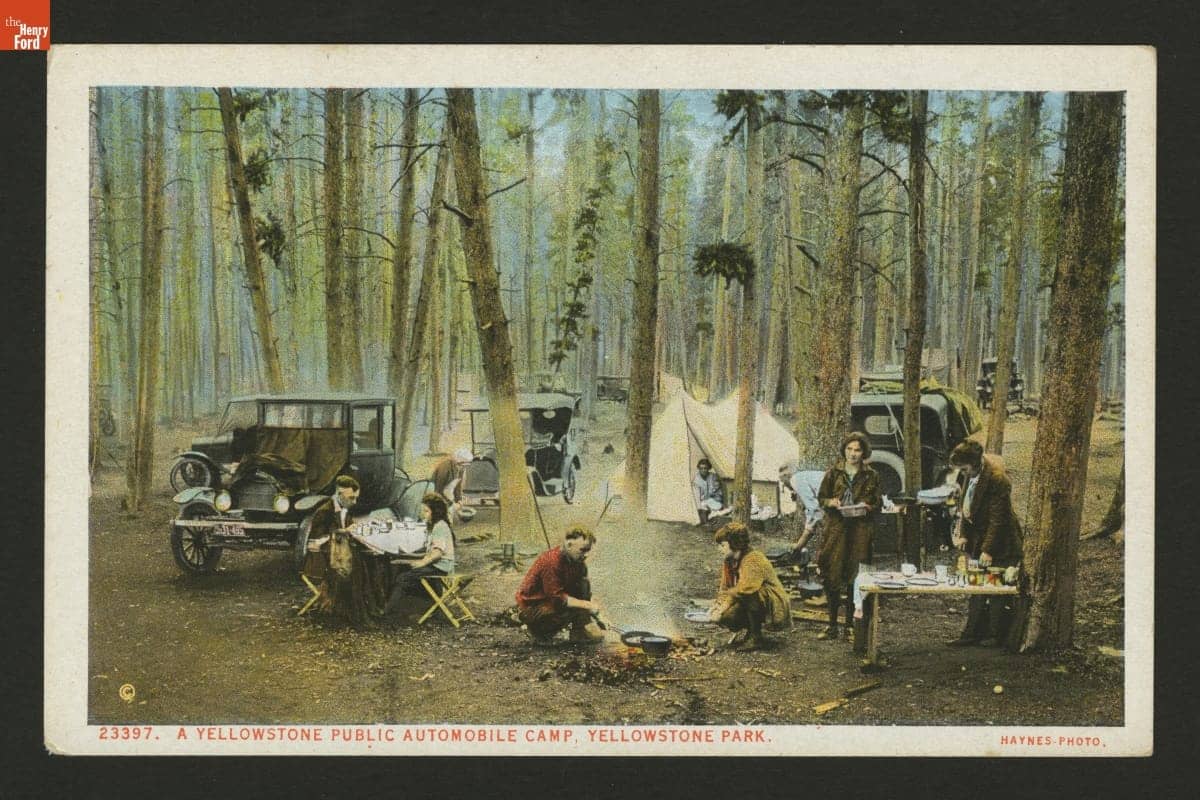
Postcard, Public Automobile Camp in Yellowstone Park, about 1920
It is inevitable, of course, that more and more motorists are arriving at Yellowstone every day. The use of automobiles in the park are bringing paved roads, parking areas, service stations, and improved public campgrounds. Most early motorists are used to roughing it and come prepared to camp.
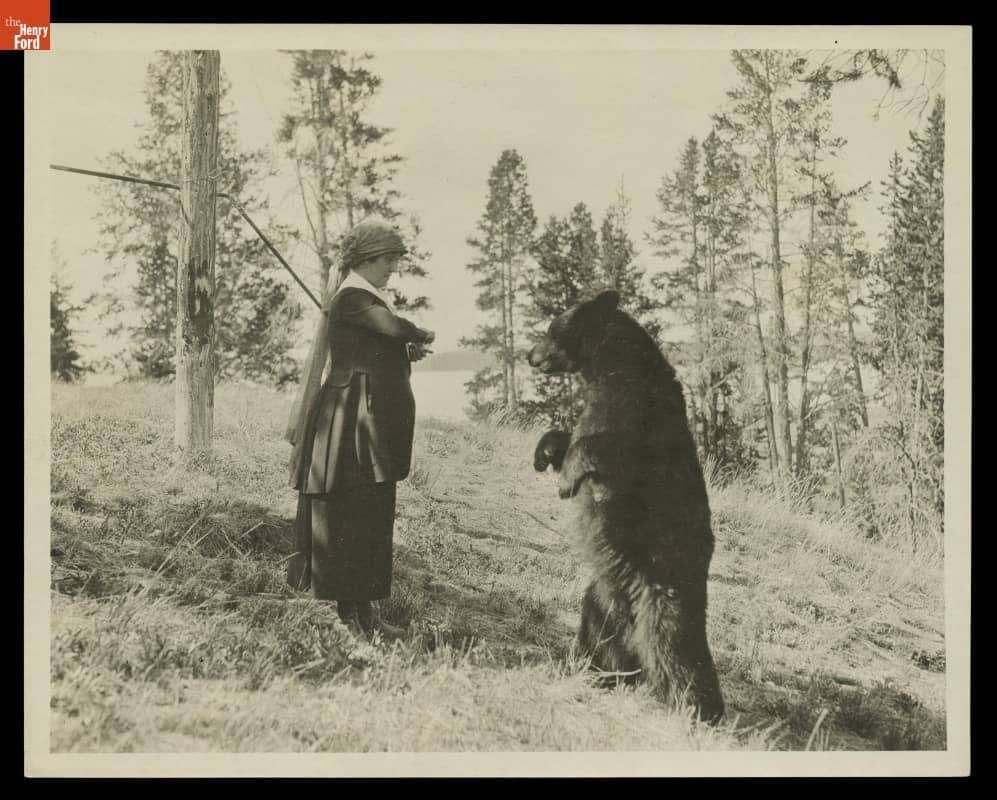
Photo, Tourist with bear, about 1917
Yellowstone will set the tone for all the other national parks to come. When the National Park Service is formally established in 1916, it incorporates many of the management principles that the U.S. Army brought to Yellowstone when its soldiers first arrived to establish order there back in 1886. Old Faithful Inn will help define the style of Western resorts and park architecture for the next several decades. Finally, as some early tourist behaviors—like feeding bears, peering into geysers, and fishing in hot springs (as shown in the postcard of Fish Pot Hot Springs)—are found to be harmful to Yellowstone’s fragile ecosystems, the park will become a testing ground for exploring and defining what it means to be a national park—serving the dual mission of preserving natural wonders while, at the same time, letting the public enjoy them.
Donna R. Braden is the Curator of Public Life at The Henry Ford.
Wyoming, Yellowstone National Park, travel, roads and road trips, postcards, nature, national parks, camping, by Donna R. Braden, 20th century, 1900s

